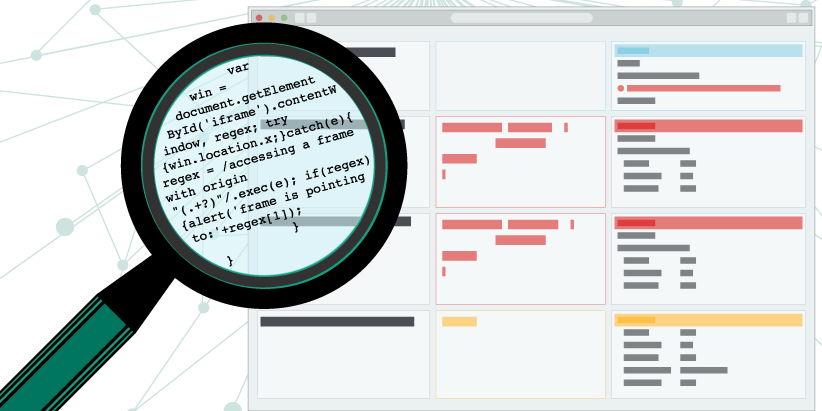
Published: 06 July 2018 at 12:30 UTC
Updated: 16 August 2022 at 09:43 UTC

I presented this research at AppSecEU, you can watch the video here:
You can download the slides here:
Exploiting unknown browsers and objects slides
We released Hackability a few months ago to enable researchers to probe unknown rendering engines using a series of tests. Hackability will also find interesting JavaScript objects but often Chrome devtools won’t be available to inspect such objects as the page is rendered without Chrome. We decided we needed a new tool focused on security to inspect JavaScript objects regardless of which rendering engine is used.
The inspector will enumerate any object by default and will attempt to find all properties using ES5/6 features and bruteforce. It will order the properties by most interesting using a list of known window properties to determine if the property is from the rendering engine or a user defined object.
When the object is enumerated it will do some checks on the property to see if it’s constructor is leaking a cross domain object which often leads to a same origin policy bypass, if you can set properties on a cross domain object, if the exception is leaking the cross domain origin, check if it’s a Java bridge and call getOwnPropertyDescriptor to retrieve information on if the property is configurable, enumerable and writable.
To use the inspector simply enter the object you wish to inspect in input box and hit return. Inspector will then show you the property name on the left and it’s value in the middle with extra information on its type on the right. Underneath the object will be the list of properties, you can enumerate these properties further by clicking the arrow. It’s possible to filter the list of properties by regex using the regex box, you can execute JavaScript on each of the properties using the js box “obj” will refer to the object in your JavaScript and “prop” will refer to the property. For example if you wanted to call every function on the object then you could do this: obj[prop](“My argument”). You can also filter each object by type using the select menu. The types filter allows you to filter by regular JavaScript types as well as window objects, cross domain window object, dom nodes, java bridges etc.
Like the Chrome devtools console you can cycle through your history using the up and down arrows. You can clear the console using Control+Backspace and clear your history using Control+Shift+Backspace. Inspector also supports HTML and if you hit Control+Enter JavaScript will be executed but not inspected (useful in multiline mode), if your command starts with a “<” character this will be detected as HTML input too.
All these options are available from the query string in case you are testing a client that doesn’t allow user interaction. The “input” parameter is the input you want to send to the inspector. “regex” parameter allows you to filter by regex, “js” parameter is the code you want to execute on every property and finally the “type” parameter allows you to filter the properties by type.
You might encounter a rendering engine that does not display the results to you. If you use the blind option as a query parameter. The inspector will render the HTML and store it so you can view it later. Simply send blind=1 as a query parameter to the inspector.
You can find a demo of Hackability inspector here but we encourage you to fork and host it on your own server.
Whilst testing Safari with Hackability inspector for the __proto__ bug I found a new cross domain issue. When trying to access a x-domain object, Safari throws an exception and includes the origin of the frame, that discloses the location of any iframe on a different domain or any cross domain window.
The code looks like this:
var win = document.getElementById('iframe').contentWindow, regex;
try {
win.location.x;
} catch(e){
regex = /accessing a frame with origin "(.+?)"/.exec(e); if(regex) {
alert('frame is pointing to:'+regex[1]);
}
}"win" contains a reference to a cross domain contentWindow from an iframe, accessing "x" throws an exception and the exception contains the origin of the iframe. If you read the length property of the contentWindow you can read every iframe origin on that window. The PoC below does that. subdomain1.portswigger-labs.net contains an iframe pointing to subdomain2.portswigger-labs.net and burpcollaborator.net, we can read the origins using the technique above.
Although the PoC above uses iframes, X-Frame-Options wouldn't save you because we could use popups instead see the PoC below.
Enter - Evaluate and inspect the input
Control + Return - Execute JS but don’t inspect and don’t return result
Shift + Return - Evaluate but don’t inspect the result
Control + Backspace - Clear the console
Control + Shift + Backspace - Clear console history
Up - Go backwards in history
Down - Go forwards in history
Up + Alt - Go backwards in history (used in multiline mode)
Down + Alt - Go forwards in history ( used in multiline mode)
input=Your input to be sent and evaluated in the console
interesting=true
regex=Filter properties of object by a regular expression
js=Execute JavaScript on every property. “obj” will refer to the object and “prop” will refer to the property.
type=Filter properties by type
blind=1
Pass input to the inspector
Only show interesting properties
Filter properties by regex
Execute js on every property
obj contains a reference to current enumerated object.
prop contains a string of the property name
Filter properties by type
The html parameter can be used to pass html
You can also pass html and then inspect it
Use the blind option to save a copy of the enumeration html when you can't see it's output
The results are stored here
Note you can't interact with this display but you can send multiple requests to determine an objects structure
You can combine all parameters